1993 BUICK REGAL mirror
[x] Cancel search: mirrorPage 153 of 308
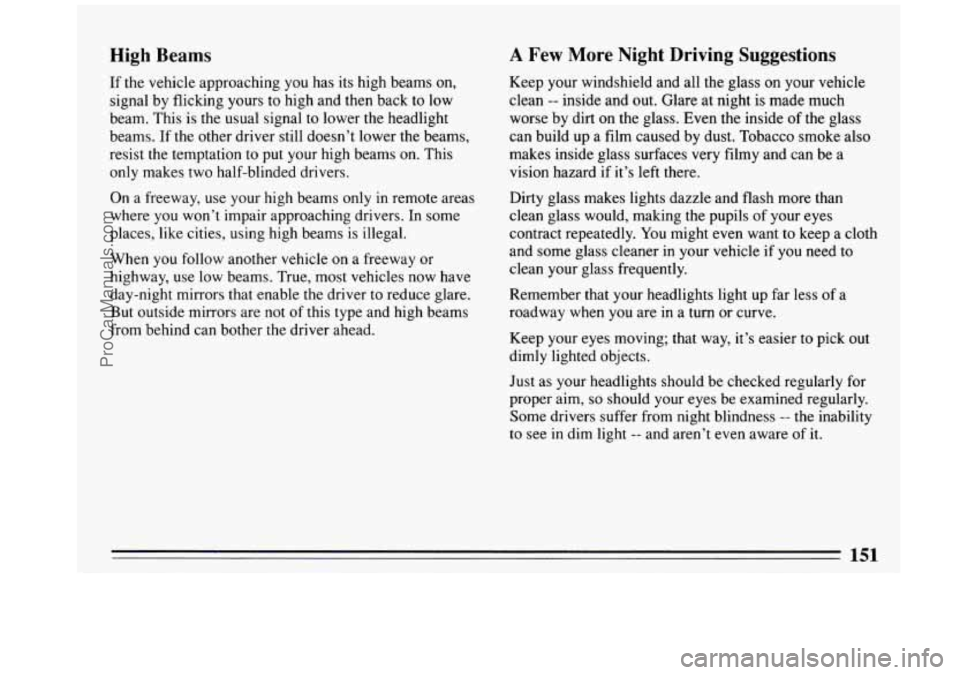
High Beams
If the vehicle approaching you has its high beams on,
signal by flicking yours
to high and then back to low
beam. This is the usual signal to lower the headlight
beams. If the other driver still doesn’t lower the beams,
resist the temptation to put your high beams on. This
only makes two half-blinded drivers.
On a freeway, use your high beams only in remote areas
where you won’t impair approaching drivers. In some
places, like cities, using high beams is illegal.
When
you follow another vehicle on a freeway or
highway, use low beams. True, most vehicles now have
day-night mirrors that enable the driver
to reduce glare.
But outside mirrors are not
of this type and high beams
from behind can bother the driver ahead.
A Few More Night Driving Suggestions
Keep your windshield and all the glass on your vehicle
clean
-- inside and out. Glare at night is made much
worse by dirt on the glass. Even the inside of the glass
can build up a film caused by dust. Tobacco smoke also
makes inside glass surfaces very filmy and can be
a
vision hazard if it’s left there.
Dirty glass makes lights dazzle and flash more than
clean glass would, making the pupils of your eyes
contract repeatedly.
You might even want to keep a cloth
and some glass cleaner in your vehicle if you need
to
clean your glass frequently.
Remember that your headlights light up far less of a
roadway when you are in a turn or curve.
Keep your eyes moving; that way, it’s easier to pick out
dimly lighted objects.
Just as your headlights should be checked regularly for
proper aim,
so should your eyes be examined regularly.
Some drivers suffer from night blindness
-- the inability
to see in dim light
-- and aren’t even aware of it.
151
ProCarManuals.com
Page 159 of 308
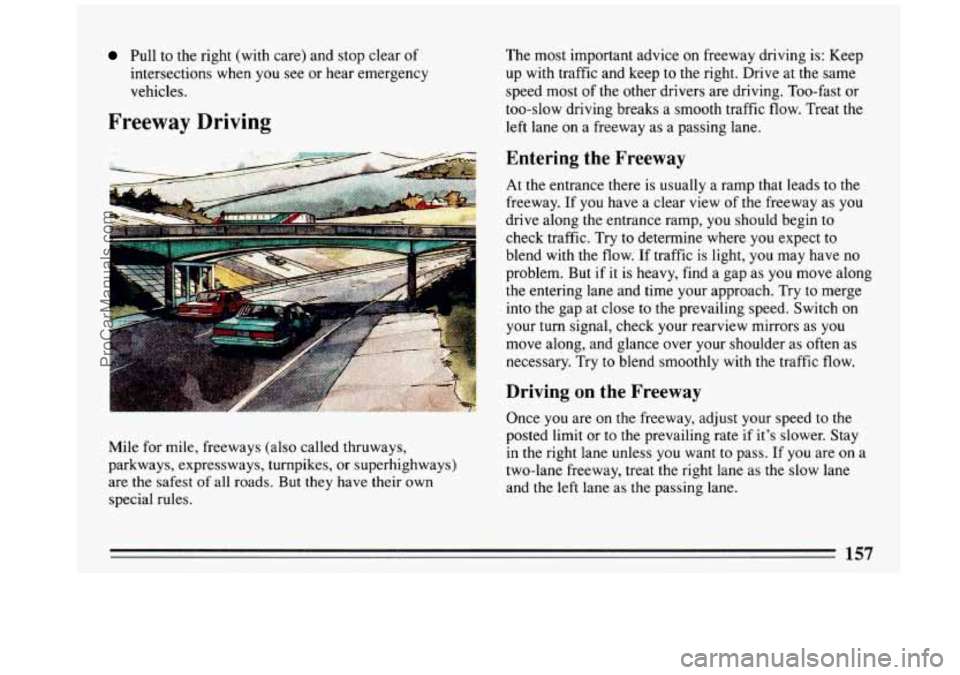
Pull to the right (with care) and stop clear or
intersections when you see or hear emergency
vehicles.
Freeway Driving
Mile for mile, freeways (also called thruways,
parkways, expressways, turnpikes, or superhighways)
are the safest of all roads. But they have their own
special rules. The
most important advice on freeway driving is: Keep
up with traffic and keep to the right. Drive at the same
speed most of the other drivers are driving. Too-fast or
too-slow driving breaks a smooth traffic flow. Treat the
left lane on a freeway as a passing lane.
Entering the Freeway
At the entrance there is usually a ramp that leads to the
freeway.
If you have a clear view of the freeway as you
drive along the entrance ramp, you should begin to
check traffic. Try to determine where you expect to
blend with the flow. If traffic is light, you may have no
problem. But if it is heavy, find a gap as
you move along
the entering lane and time your approach. Try to merge
into the gap at close to the prevailing speed. Switch on
your turn signal, check your rearview mirrors as you
move along, and glance over your shoulder as often as
necessary. Try to blend smoothly with the traffic flow.
Driving on the Freeway
Once you are on the freeway, adjust your speed to the
posted limit or to the prevailing rate if it's slower. Stay
in the right lane
unless you want to pass. If you are on a
two-lane freeway, treat the right lane as the slow lane
and the left lane as the passing lane.
157
ProCarManuals.com
Page 160 of 308
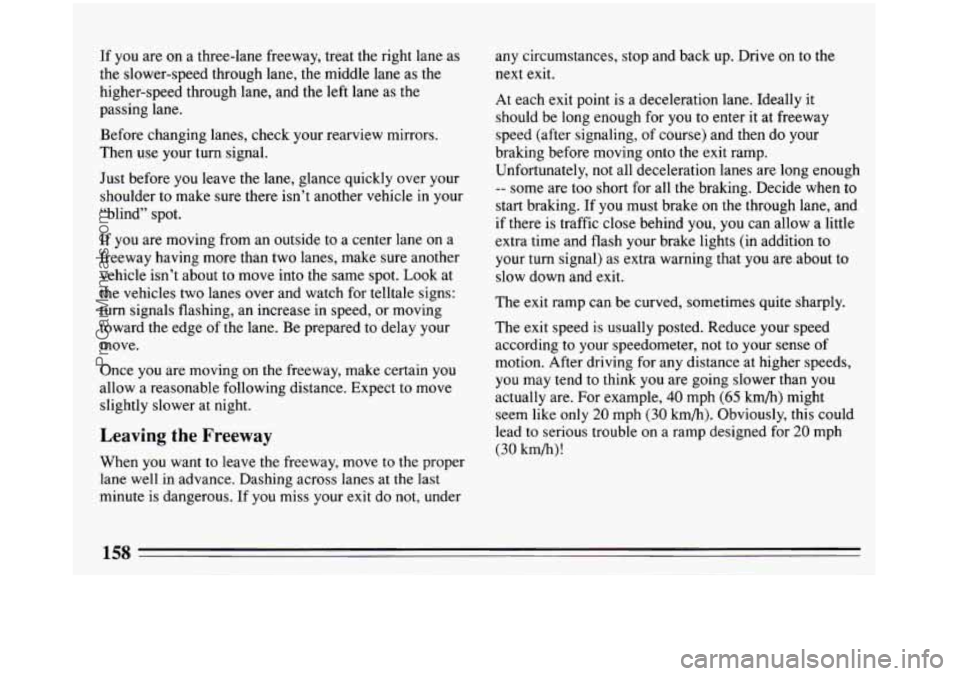
If you are on a three-lane freeway, treat the right lane as
the slower-speed through lane, the middle lane
as the
higher-speed through lane, and the left lane as the
passing lane.
Before changing lanes, check your rearview mirrors.
Then use your turn signal.
Just before you leave the lane, glance quickly over your
shoulder
to make sure there isn’t another vehicle in your
“blind” spot.
If you are moving from an outside to a center lane on a
freeway having more than two lanes, make sure another
vehicle isn’t about to move into the same spot. Look at
the vehicles two lanes over and watch for telltale signs:
turn signals flashing, an increase in speed, or moving
toward the edge
of the lane. Be prepared to delay your
move.
Once
you are moving on the freeway, make certain you
allow a reasonable following distance. Expect
to move
slightly slower at night.
Leaving the Freeway
When you want to leave the freeway, move to the proper
lane well in advance. Dashing across lanes at the last
minute is dangerous.
If you miss your exit do not, under any
circumstances, stop and back up. Drive
on to the
next exit.
At each exit point is a deceleration lane. Ideally it
should be long enough for
you to enter it at freeway
speed (after signaling, of course) and then do your
braking before moving onto the exit ramp.
Unfortunately, not all deceleration lanes are long enough
-- some are too short for all the braking. Decide when to
start braking. If you must brake
on the through lane, and
if there is traffic close behind you, you can allow
a little
extra time and flash your brake lights (in addition to
your turn signal) as extra warning that you are about to
slow down and exit.
The
exit ramp can be curved, sometimes quite sharply.
The exit speed is usually posted. Reduce your speed
according to your speedometer, not to your sense
of
motion. After driving for any distance at higher speeds,
you may tend to think you are going slower than you
actually are. For example,
40 mph (65 km/h) might
seem like
only 20 mph (30 km/h). Obviously, this could
lead
to serious trouble on a ramp designed for 20 mph
(30 km/h)!
158
-
ProCarManuals.com
Page 162 of 308
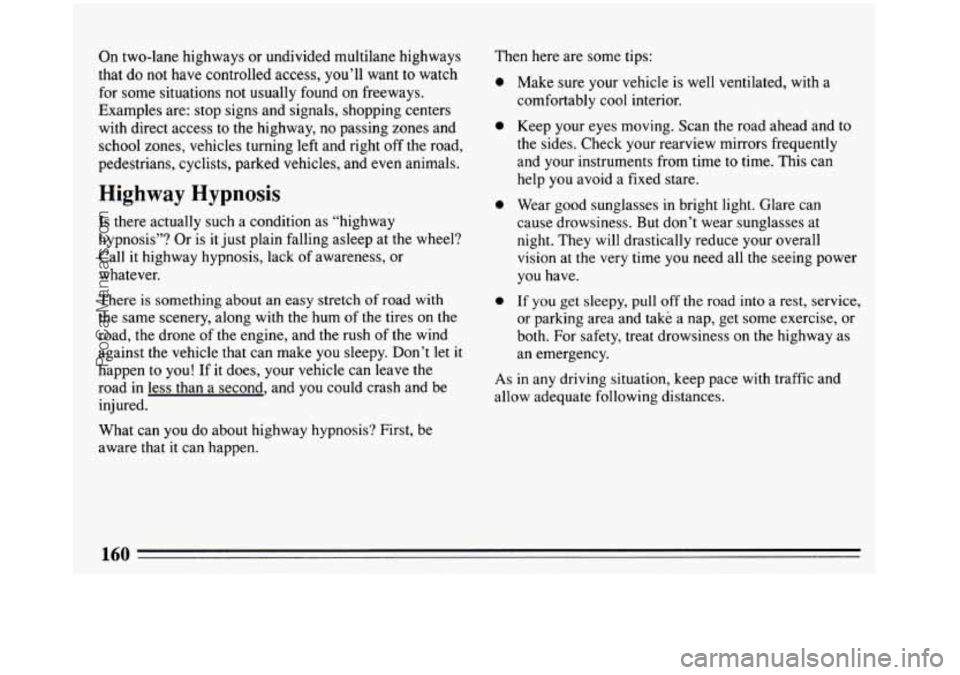
On two-lane highways or undivided multilane highways
that do not have controlled access, you’ll want to watch
for some situations not usually found on freeways.
Examples are: stop signs and signals, shopping centers
with direct access to the highway, no passing zones and
school zones, vehicles turning left and right
off the road,
pedestrians, cyclists, parked vehicles, and even animals.
Highway Hypnosis
Is there actually such a condition as “highway
hypnosis”? Or is it just plain falling asleep at the wheel?
Call it highway hypnosis, lack
of awareness, or
whatever.
There is something about an easy stretch
of road with
the same scenery, along with the hum of
the tires on the
road, the drone of the engine, and the rush
of the wind
against the vehicle that can make
you sleepy. Don’t let it
happen to
you! If it does, your vehicle can leave the
road in less than a second, and you could crash and be
inj ured.
What can you
do about highway hypnosis? First, be
aware that it can happen. Then
here are some tips:
0
0
0
0
Make sure your vehicle is well ventilated, with a
comfortably cool interior.
Keep your eyes moving. Scan the road ahead and to
the sides. Check your rearview mirrors frequently
and your instruments from time
to time. This can
help you avoid a fixed stare.
Wear good sunglasses in bright light. Glare can
cause drowsiness. But don’t wear sunglasses at
night. They will drastically reduce your overall
vision at
the very time you need all the seeing power
you have.
If you get sleepy, pull off the road into a rest, service,
or parking area and take a nap, get some exercise, or
both. For safety, treat drowsiness on
the highway as
an emergency.
As in any driving situation, keep pace with traffic and
allow adequate following distances.
ProCarManuals.com
Page 175 of 308
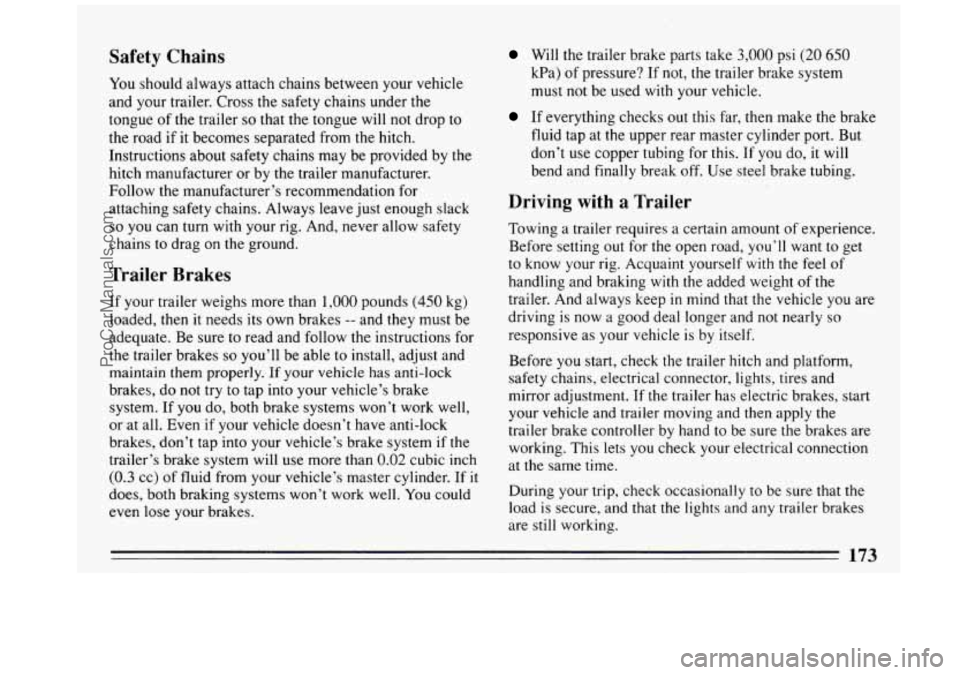
Safety Chains
You should always attach chains between your vehicle
and your trailer. Cross the safety chains under the
tongue of the trailer
so that the tongue will not drop to
the road if it becomes separated from the hitch.
Instructions about safety chains may be provided by the
hitch manufacturer or by the trailer manufacturer.
Follow the manufacturer’s recommendation for
attaching safety chains. Always leave just enough slack
so you can turn with your rig. And, never allow safety
chains to drag on the ground.
Trailer Brakes
If your trailer weighs more than 1,000 pounds (450 kg)
loaded, then it needs
its own brakes -- and they must be
adequate. Be sure
to read and follow the instructions for
the trailer brakes
so you’ll be able to install, adjust and
maintain them properly. If your vehicle has anti-lock
brakes, do not try
to tap into your vehicle’s brake
system. If you do, both brake systems won’t work well,
or at all. Even if your vehicle doesn’t have anti-lock
brakes, don’t tap into your vehicle’s brake system if
the
trailer’s brake system will use more than 0.02 cubic inch
(0.3 cc) of fluid from your vehicle’s master cylinder. If it
does, both braking systems won’t work well.
You could
even
lose your brakes.
Will the trailer brake parts take 3,000 psi (20 650
kPa) of pressure? If not, the trailer brake system
must not be used with your vehicle.
If everything checks out this far, then make the brake
fluid tap at the upper rear master cylinder port. But
don’t
use copper tubing for this. If you do, it will
bend and finally break
off. Use steel brake tubing.
Driving with a Trailer
Towing a trailer requires a certain amount of experience.
Before setting out for
the open road, you’ll want to get
to know your rig. Acquaint yourself with the feel of
handling and braking with the added weight of the
trailer. And always keep
in mind that the vehicle you are
driving is
now a good deal longer and not nearly so
responsive as your vehicle is by itself.
Before you start, check the trailer hitch and platform,
safety chains, electrical connector, lights, tires and
mirror adjustment. If the trailer has electric brakes, start
your vehicle and trailer moving and then apply the
trailer brake controller by hand to be sure
the brakes are
working. This lets you check your electrical connection
at the same time.
During your trip, check occasionally
to be sure that the
load is secure, and that the lights and any trailer brakes
are still working.
172
ProCarManuals.com
Page 259 of 308

Fuses and Circuit Breakers
The wiring circuits in your car are protected from short
circuits by a combination
of fuses, circuit breakers, and
fusible themdi links in the wiring itself.
This greatly
reduces the chance
of fires caused by electrical problems.
This fuse panel is inside the
glove box. Pull the cover
down for access. Some
spare fuses and
a fuse
puller are included.
Be sure
to use the correct fuse. If you ever have a problem
on the road and don’t have
a spare fuse, you can “borrow”
one of the correct value. Just pick some feature of your car
that you can get along without
-- like the radio or cigarette
lighter
-- and use its fuse, if it is of the value you need.
Replace
it as soon as you can.
Fuse Usage
Amp Description
1.
2.
3.
10
15
15
4.
5.
6.
7.
8.
9.
10.
11.
12.
13.
14.
1s.
16.
17.
18.
25
10
1s
15
20
15
10
5
25
10
10
Radio & Clock
Radio
& Clock; Instrument Cluster; Passive
Restraint Timer
Courtesy, Glove Box, Underhood, Trunk, Header
Lights; Cigarette Lighter; Lighted Inside Rearview Mirror; Power Door Locks; Power Mirrors
Windshield Wiper
& Washer
Cruise Control: DRL Module; Instrument Cluster;
HVAC
Brake Lights;
ABS Control Module; Chime Module
Engine Control Module
Taillights; DRL Module
Hazard Warning Flasher
Rear Defogger Timer Relay: Instrument Cluster;
Chime Module; Cruise Control; DRL Module; Lamp
Driver
Module; ABS Lamp Driver
Instrument Panel. Console, Switch Lights
Blower Motor
Turn Signals
Not Used ABS Control Module
Not Used Not Used
Not Used
257
ProCarManuals.com
Page 264 of 308
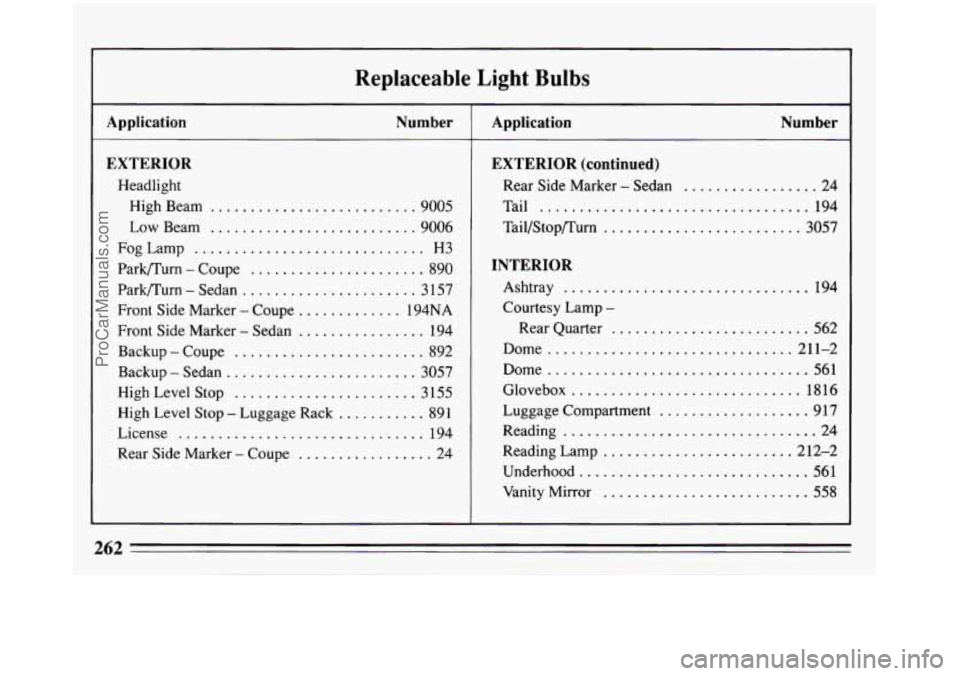
Replaceable Light Bulbs
A nplication Number
.
EXTERIOR
Headlight
High Beam
.......................... 9005
Low Beam .......................... 9006
FogLamp
............................. H3
Park/Turn
. Coupe ...................... 890
Park/Turn
. Sedan ...................... 3 157
Front Side Marker
. Coupe ............. 194NA
Front Side Marker
. Sedan ................ 194
Backup
. Coupe ........................ 892
Backup-Sedan
........................ 3057
~ High Level Stop ....................... 3155
High Level Stop
. Luggage Rack ........... 891
License
............................... 194
Rear Side Marker
. Coupe ................. 24
Application Number
EXTERIOR (continued)
Rear Side Marker . Sedan ................. 24
Tail
.................................. 194
Tail/Stop/Turn
......................... 3057
INTERIOR
Ashtray ............................... 194
Courtesy Lamp
.
Rear Quarter ......................... 562
Dome
............................... 211-2
Dome
................................. 561
Glovebox
............................. 1816
Luggage Compartment
................... 917
Reading
................................ 24
Reading Lamp ........................ 2 12-2
Vanity Mirror
.......................... 558
Underhood ............................. 561
262
. .
ProCarManuals.com
Page 297 of 308

Child Restraints .................................. 42
Children and Safety Belts
.......................... 40
Cigarette Lighter ................................. 97
Circuit Breakers
................................. 257
City Driving
.................................... 156
Cleaner. Air
.................................... 225
Cleaning Aluminum Wheels
............................ 252
Fabric
...................................... 249
Glass
....................................... 251
Inside of Your Car
............................. 248
Leather and Vinyl
............................. 250
Outside Of Your Car
........................... 251
Power Antenna
............................... 124
Top of the Instrument Panel
..................... 250
UnderbodyofYourCar
........................ 253
Safety Belts
.................................. 251
Windshield Wiper and Blades
.................... 251
Weather Strips
................................ 253
White Sidewall Tires
........................... 253
Clock. Setting the
............................ 1 16. 120
Closed-In Places. Don’t Idle in
...................... 78
COinExhaust
................................... 78
Color
of Road Signs .............................. 128
Comfort Controls and Audio Systems
................ 109
Compact Spare Tire
.............................. 210
Contents. Table of
................................. 9
. Compact Disc Care .............................. 124 Control
of a Vehicle
.............................. 138
Control. Loss of
................................. 148
Controls. Features and
............................. 57
Convex Outside Mirror
............................ 94
Coolant. Engine.
................................. 228
Coolant. Engine. Warning Gage
..................... 103
Coolant. Safety Warnings About
.................... 195
Courtesy Lights
.................................. 94
Covers. How to Remove Wheel
..................... 203
Cruise Control
................................... 86
Cruise Control. Change Speed With
.................. 89
Cruise Control. Turning
Off ......................... 91
Cruise Control Using on Hills
....................... 90
Curves. Driving on
............................... 144
Customer Assistance Information
................... 285
Customer Assistance for the Hearing and Speech Impaired 286
Customer Satisfaction Procedure
.......... : ......... 285
D (Drive) Third Gear ............................. 72
@ Automatic Overdrive ........................... 72
Damage to Finish
................................. 253
Damage to Sheet Metal
........................... 253
Damage Warnings
................................ 11
Daytime Running Lights
........................... 92
Dead Battery
.................................... 180
Defensive Driving
............................... 134
Defogger, Rear Window
.......................... 113
295
ProCarManuals.com